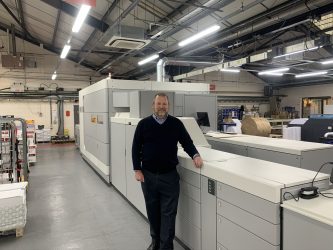While the lockdown has hit many commercial printers hard, one area is bearing up – transactional and direct mail, the former because it’s still a legal requirement, and the latter because it offers cut-through and tangible presence in a disconnected virtual world. Michael Walker took up his post
As if we weren’t living our lives digitally enough before the Coronavirus reached our shores, the lockdown imposed from late March and only now being cautiously lifted has pushed everyone’s activity online, whether it’s business meetings by Zoom, Teams or Skype, shopping for everything bar locally-available necessities, teaching via Google Hangouts, family get-togethers via WhatsApp or quizzes and games on a host of platforms. More and more of life is being conducted via a screen of some kind and many of us go to bed these days quite square-eyed from too much screen time.
Marketers who espouse print were already warning of digital fatigue for years before this acceleration, with many critical of precise but meaningless ‘engagement’ figures from digital channels. Mike Hughes, managing director of Bristol-based Latcham Direct, comments, ‘The immediacy of digital solutions meant that it was inevitable and predictable that people would immediately move online during an event such as this one, but even before Covid-19 there was evidence that people experienced digital fatigue.
‘Printed products have a premium feel, and evoke other sensations and emotions that digital products are simply unable to do, especially the kind of premium printed products we are capable of creating. Keeping that blended approach can help our clients rise above the digital noise and stand out in an increasingly crowded digital space.’

Datagraphic staff with Hunkeler kit inline to the Xerox Trivor press
Mixed media
The point made repeatedly both by marketing agencies and by printers involved in the sector is that it’s not print or digital, it’s both. As well as being firmly endorsed by marketers who still see print as an essential channel, printers whose businesses have in the past principally relied on mailed products also see them as complementary. Rugby-based Datagraphic, a transactional mail specialist, offers both physical and digital ‘mailing’, both via its inhouse developed Aceni web-based software and through more conventional data transfer processes.
For Datagraphic, which managing director Glyn King says provides ‘no – zero – direct mail’ but prints and sends communications which are ‘expected and have consequences’, such as payslips, bank and pension statements, invoices and debt letters, the decision to go multi-channel was made a decade ago.
‘At the time it looked like a turkey voting for Christmas,’ recalls Mr King, ‘a printer advocating not printing, but now we turn over £14 million through organic growth and 25% of our revenues have no print component. We take clients on a ‘digital journey’, which can include print as well.’
The non-print part is provided by online portals where the recipients of transactional communications can log in to view messages, text messaging and secure email via Datagraphic’s own Aceni software. By volume, however, this represents about 10% of the business, with the rest being print. This puts some demands on the print side. ‘Maintaining capacity for print means constant investment, people get used to digital delivery speeds,’ he explains.
A long-standing Xerox house, Datagraphic has been through most generations of the US company’s technology, including Nuvera, iGen and more recently, Versant sheet-fed toner printers, as well as being the first in Europe to take a Rialto press in 2015. ‘Xerox’s inkjet technology gave us reel-to-sheet capability which enabled speed. Data received at 4pm can be delivered to mobile phones in 15 minutes, and print goes the same day into the postal system,’ says Mr King.
It’s the reel-to-sheet capability that’s key to the speed, the inkjet printing technology is incidental for Datagraphic, though Mr King acknowledges that it’s ‘lucky’ his clients are in the transactional space rather than promotional and so not so demanding of image quality. A second Rialto was bought in 2016, but the first one has now made way for a Trivor HD 2400 that was installed in September 2019, the sixteenth Xerox press the company had bought. It’s paired with a Hunkeler Series 8 paper handling and finishing line.
A Böwe Systec letter sorting line was installed last November, able to handle up to 46,500 letters per hour, but plans to add an enclosing line, also from Böwe, in March of this year, had to be put back because of Covid-19 site regulations. It’s now hoped that this installation will go ahead in late June or early July.
Datagraphic’s business is contract-based, with service level agreements (SLAs) forming a key part of contracts, so shutting up shop when the lockdown hit wasn’t an option. Mr King commented, ‘We produce and distribute critical multi-channel communications for key industries. Non-delivery has real consequences for people waiting on medical or payroll information, for example. So when Coronavirus started we had to channel all efforts on protecting our resources.
‘Thankfully, we have robust business continuity plans and our team have been incredible. Every day I see or hear someone in the business going above and beyond to meet SLAs for our clients. One client recently said he hadn’t thought about Datagraphic once during the pandemic, and it was like Covid-19 wasn’t happening, because the service was running business-as-usual.
‘Encouragingly we’ve welcomed some new clients during coronavirus. We’ve been helping people get important information sent out via our multi-channel platforms,’ he adds, commenting also on the role of supplier support during the period, ‘Xerox and Hunkeler support has not been affected during the crisis. We worried when it was reported Xerox had furloughed engineering staff but our worries were dealt with swiftly by Xerox and we have received fantastic support during a busy period.’
Roll-fed inkjet was also the choice at Leeds-based Mailing and Marketing Services (MaMs), who were the first UK site for Ricoh’s flagship VC70000 press first shown to the world at last year’s Hunkeler Innovationdays. Owner Anthony Krajniewski told Digital Printer that key factors in its selection were its fast make-ready and the ability to support offset paper types. Colour consistency and lack of banding were also factors. ‘Digital print brings value back in-house and adds flexibility in options,’ he adds.

Latcham Direct’s Mike Hughes with the Canon VarioPrint i300
That’s a wrap
A key strategic move for MaMs, which provides commercial direct mail print and mailing services for a range of clients from charities to the NHS to magazine publishers, is into paper wrapping of mail products, which as well as meeting environmental goals to move away from plastics, enables versioned or even fully personalised advertising on the wrapper as well. The Ricoh press is supported by Hunkeler paper handling and finishing equipment, while Stahl and MBO folders, a Bobst 2000 die cutter and CMC JWR wrapping lines can handle print from any source, though the die-cutter is inline to the VC70000; it can cut everything from window in envelopes to promotional bags, according to Mr Krajniewski.
The wrappers won’t initially be exclusively printed digitally – the company produces some 10 million mail packs a week and in early February was expecting to handle half a billion this year, utilising eight enclosing lines across its sites in Leeds and Wolverhampton, claimed to be the most in the world, for paper wrapping. It is still making the transition away from sheet-fed litho but Mr Krajniewski anticipates that more of its output will go all-digital as ink prices reduce. It’s possible that a second VC70000 might be added, though the impact of the Coronavirus has pushed those plans back.
The commissioning of the Ricoh press was also delayed by the onset of the Covid-19 restrictions but it went into operation in May, working on a limited range of substrates, as the on-site tweaking and training to reach the full capability hasn’t yet been possible. Managing director Danny Narey, who took up the post at the start of April, says, ‘Our clients haven’t been hit as badly as we thought; 80–82% of packs are still expected, though some sectors – travel and leisure – have fallen off a cliff, while
home shopping and crafting have rocketed. The content is welcomed, it’s a distraction. If there are swings and roundabout, the roundabouts have been quite good for us.’ He adds that although some 60% of staff had been furloughed, most were back by early June and all would be by early July. ‘We’re seeing recovery past the trough and starting to come out the other side; home shopping clothing has been much busier in the last two or three weeks,’ he says.
Another client sector that’s held up well is gaming. ‘The bingo/casino ‘clicks’ business is open, they’ve been mailing to encourage customers online,’ says Mr Narey, adding, ‘Digital print comes into play here, as they had to adjust the message and the copy, so flexibility was needed. We’re doing this both cut-sheet and about to go on the VC70000, using a 250gsm silk offset paper.’ MaMs also has a Xerox Iridesse sheet-fed toner press but doesn’t use it for its special colour or effects capabilities but more as a CMYK workhorse, handling a million pages a month, plus two Xerox Nuvera mono toner printers.
Mr Narey feels that Ricoh has cracked the inkjet goal of printing on offset paper with the VC70000. ‘It’s got the colour gamut, and proven that Fogra 54 can be matched or exceeded, though we’re not selling on that,’ he confirms. ‘The industry talks about litho replacement. Not us. We can tick the ‘prints as well as litho’ box, but we ask ‘what else?’ –seasonality, audience of one, fast turnaround?’
He echoes Mr Krajniewski’s comments on the control that digital print in-house brings. ‘It’s about data and control versioning, response codes, match mailing. Some customers just want footfall in stores but clothing companies do care about the source of leads, their demographics,’ he says.
‘There’s definitely e-fatigue. People enjoy the interaction with something physical, some post to open over muffins and marmalade. Touch and feel engenders trust. There’s also the idea that magazines help with mental health – and some evidence that porous materials [like paper] that wick water away from the surface dry and kill the virus,’ he adds.

Glyn King of Datagraphic
Sheet-fed solutions
At Latcham Direct, which has clients in utilities, healthcare, financial services, electoral services and membership, the choice was to go for the newly emerging category of sheet-fed inkjet with two Canon Océ VarioPrint i300s, the first installed in the summer of 2019 and the second at the beginning of this year, both supported by inline Hunkeler sheeting and feeding into offline Duplo iSaddle booklet makers and a fleet of BlueCrest/Pitney Bowes inserters.
Having come like MaMs from a toner technology background, Latcham felt that toner was becoming less
commercially competitive in terms of speed and costs to support work in high volume direct mail and transactional work. Investigations into inkjet alternatives led to the i300 when it was launched. ‘There were only a couple of other devices on the market at this time and we ran tests across all devices,’ says Latcham managing director Mike Hughes. ‘We reviewed the print sample tests and the quality was best in class. Whilst the device was considerably more expensive, it was more durable. The running costs and ROI modelling showed that overall it would meet the commercial and operational requirements.
‘Another consideration was sustainability, and the desire to move away from microplastic-based toner to water-based inks, which we could do with the i300. It also runs at decreased energy per page, contributing to our drive for more eco-friendly printing,’ he adds.
That said, toner does still have a role at Latcham, with Canon ImagePress C850 and C910 models with 1300mm long sheet options for higher quality graphic arts work. A Ricoh IP5000 inkjet is used for higher volume letters and forms, while the i300s are used for on-demand high quality and personalised print.
Although Covid-19 has had an impact, Latcham arrived at the start of the period with an ‘excellent’ year-on-year position and Mr Hughes reports that things have held up well in the circumstances, with volumes at 70% of normal, as much of the business is connected with the fulfilment of transactions, contracts, membership and policy documents.
With many people still largely at home, either working from there or furloughed, there’s perhaps never been a better time to mail them.





